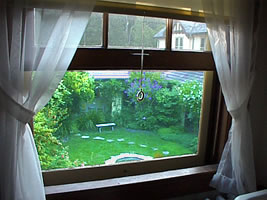Asian bodywork uses gentle hand and finger pressure along the body’s energy channels. The objective is to restore and balance the flow of energy throughout the body.
There are many forms of Asian bodywork, some well known (Shiatsu), some obscure (Seiki Soho). What they have in common is their foundation in Chinese Medicine. They differ in their use of specific techniques to balance energy.
Below you’ll find brief descriptions of styles that I have practiced. (Please note that I am not currently seeing new clients.) The links in each description take you to a longer article with more detail.
Acupressure
In Acupressure therapy, the practitioner uses a variety of tools (pulse and tongue diagnosis, questioning, looking, listening) to assess the relative strength of the twelve organ meridians. She then addresses specific physical complaints and their corresponding energy imbalances by working on individual energy channels. An acupressure treatment is very relaxing and eases you into a healing, meditative state.
Tui Na
In a Tui Na session, the practitioner uses standard Chinese Medicine assessment skills, but also uses extensive hands-on touch to locate areas of the body that are out of balance. Imbalances are addressed using soft tissue massage, joint mobilization, and gentle pressure on energy points.
This is a fairly active form of Asian bodywork — the practitioner remains in motion during the session and there is always something new happening. If you like conventional Swedish massage, you will undoubtedly enjoy Tui Na. It leaves you feeling both relaxed and invigorated. (See also What Is Tui Na?)
Jin Shin Jyutsu
Jin Shin Jyutsu is a highly developed form of acupressure therapy. Due to its gentleness and effectiveness, it is increasingly used in hospitals and outpatient settings as a complement to conventional healing methods. My sense of the practitioners I’ve met is that many have recovered from serious health conditions. They were inspired to become practitioners after experiencing the benefits of Jin Shin Jyutsu.
Unfortunately, people often learn of this work only after they become ill. It’s an excellent way to maintain one’s health, both through regular sessions and the use of an extensive array of easily applied self-help techniques.
Five Elements Acupressure
The Five Elements or Five Phases theory of acupressure is a way of organizing and analyzing a vast array of information about the human condition. The ancient Taoists observed patterns in Nature and grouped them into the five categories: Wood, Fire, Earth, Metal, and Water. Since human beings are a microcosm of Nature, we can find these same patterns in ourselves.
In Five Elements acupressure, the practitioner uses all available information to determine how the Elements are interacting with each other in the client’s body. Balance is restored using points on the energy channels that correspond to the Five Elements. For clients, an important part of ongoing sessions is an increased understanding of the Element that corresponds to their fundamental nature. We find balance by living in harmony with our Five Element type.
Shiatsu
Shiatsu is a style of Asian bodywork known for its use of rhythmic compression along energy channels. Like Tui Na, it makes extensive use of muscle stretching and movement of the joints. A Shiatsu practitioner often emphasizes the importance of her state of mind: She establishes contact with the client through touch and maintains a focused, meditative state throughout the session. In my experience, this is not unique to Shiatsu, but is a characteristic of an individual practitioner’s style.

